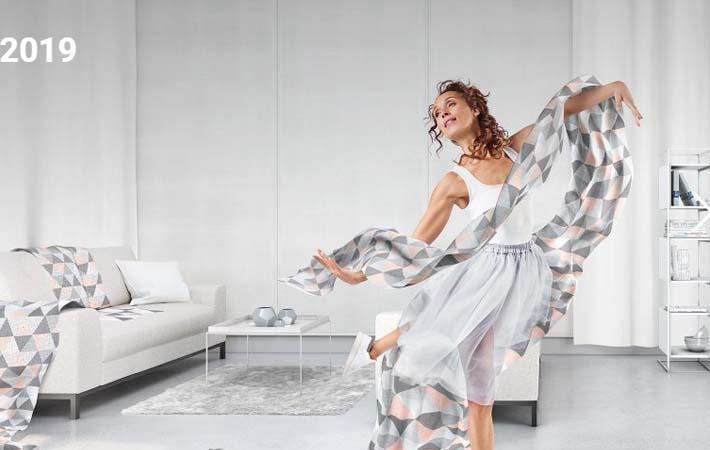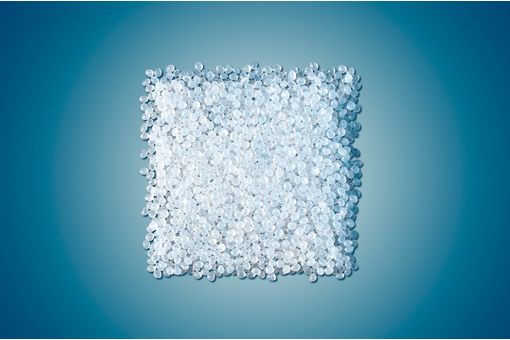Graphic patterns emerge as key trends in Heimtextil

Heimtextil 2019 demonstrated graphic patterns as the must-have of the season for all segments, from carpets, wall and window decoration to furniture and decorative fabrics and on the table, in the bathroom and in the bedroom. These included variations on geometries, checks, diamonds and diagonal stripes as well as inspirations from the 50s, 60s and 70s, elegant style elements from Art Deco and designs à la MC Escher.
The latter in particular, with their strong three-dimensional optics, form a link to the second top trend: very haptic structures provide exciting inspiration for the eye and hand across all types of textiles. The consistently grippy fabrics convey aspects such as craftsmanship, quality and authenticity. These include cotton and linen looks with typical slub elements, elaborate traditional weaves, interesting cut-outs and material mixes, elements borrowed from outdoor and functional clothing as well as the ubiquitous patina effects.
These structured surfaces appear particularly elegant in the combination of dark grey and silver tones with natural, often light non-colours. The compositions are complemented mainly by powdery pastels from rose and lilac to mint and blue. The deliberate blending with light shades of grey gives the colour fan a casual and adult touch. Parallel to this, the denim trend continues to develop, flanked by a robust style in mud and khaki shades mixed with bright orange. All in all, the colour worlds appear very coordinated and harmonious. Strong accents of gold and mustard yellow or ultraviolet are to be found above all in the opulent, more luxurious collections.
In the new Heimtextil trade fair concept, certain halls were convincing as a compact meeting place for furniture and decorative fabrics, upholstery and imitation leather, carpets and contract business. In addition to the important design components, the themes of health and sustainability came to the fore. This trend was expressed partly in the numerous new products related to recycling, upcycling and cradle to cradle. Innovators such as Trevira CS and Antex focused on new processes and used marine waste such as fishing nets and PET bottles as raw materials for their recyclable yarns. The company Froca, presented its nanotechnology-based innovation, a Teflon-free upholstery fabric line that can be cleaned with pure water.
A rethink of carpets was also depicted: suppliers such as Toucan-T presented PVC, latex and bitumen-free solutions that save around 12,600 tonnes of waste and 70,000 barrels of crude oil per 10,000 tonnes of raw material. The growing trend towards carpet tiles also offers more than just design advantages over rolled goods. This is because the smaller packaging units reduce CO2 values simply by improving transport options.
Textiles and floor coverings that are characterised by their health-promoting aspects were also in demand. Products by exhibitors such as Tecnografica, Cerda Fabrics and Essegomma were odourless, breathable, antibacterial and anti-allergenic. They had sound-absorbing abilities and/or clean the air in the room thanks to their special characteristics. Suppliers such as Höpke are marking the paradigm shift in the elderly and care sector with particularly easy-care and at the same time attractive fabrics.
Interest in sustainable solutions is also growing in digital printing, which was given a new position at Heimtextil. International market leaders such as HP are increasingly developing sustainable alternatives, including latex technologies that can be combined with recyclable materials, as well as a range of water-based inks and odourless prints that are also suitable for hospitals and schools. In terms of design, exhibitors like Mimaki demonstrated their skills in adapting one and the same work of art (Tessa Koops) on canvas, wallpaper and textile.
Suppliers such as AS Création, ATT Rotex, Rasch, Grandeco, Architects Paper and Galerie inspired people to seek out new walls. The looks ranged from industrial and rustic-natural to sophisticated Art Deco, which also fits in well with the unmistakable renaissance of the peacock motif. The very haptic qualities, including wall, stone and plant looks, are and will remain in vogue. Designs from European metropolises, from London club chic to Amsterdam tile styles (AS Design), provide fresh impetus. In the case of motifs, graphic and geometric patterns in particular appeared to replace floral designs. Geometric metallic structures, for example, have an impressive effect. Oversized enlarged dots or plant details such as those to be found at Wallpera and Casadeco pop up in between and look fresh and colourful. Technical innovations can be found among almost all suppliers in the field of fire protection and odourless materials. However, cost-effective roller solutions as an alternative to complex digital printing, for example with Rasch, also ensure movement in the industry.
Exhibitors such as Apelt, Eustergerling, Heco, IFI Design, Saum & Viebahn and Style Library fully exploited the creative strength of decorative textiles at the new Interior Decoration hotspot. As part of impressive presentations, they immersed visitors in different style worlds. In line with the major trends, graphic designs dominated the scene. These range from simple geometric patterns such as diamonds, checks and stripes to complex, multi-coloured optical illusions. The sophisticated mix of different yarns, weaves and materials plays just as important a role as the alternation between translucency and opacity: curtains and blinds exhibit openwork patterns, cut-outs and patina aspects. High-quality ‘patchwork carpets’ give rise to exciting, haptic creations with piles of different heights. Matching sofa and cushion covers are characterised by two-tone mottled and grippy structures.
Intelligent darkening systems such as those from Buchheister not only provide privacy but also become an attractive design element.
Exhibitors such as Lanerossi, Silkeborg Uldspinderi and Zoeppritz presented trends for blankets, cushions and plaids, that is accessories that can be used to give interiors a lift on a seasonal basis. They impressed with wide and very harmonious colour fans. In amongst the pastels that also dominated here, an urban hunting lodge feeling arises with robust brown and khaki shades in combination with bright orange. Fans of the 70s will be pleased with a special novelty: the good old terry cloth has found its way into interior design.
Particular attention was paid by Heimtextil 2019 to sleep as a new lifestyle theme. The various solutions for improving nightly regeneration ranged from hotel beds that can be individually adjusted to suit the guest (GX by Rummel) and smart sleep sensor mats from Withings Sleep to technical materials from space travel at Outlast Technologies. These regulate the temperature during sleep by changing their physical state. Sustainability also moved further into focus. (SV)
Fibre2Fashion News Desk – India
































-Ltd..jpg?tr=w-120,h-60,c-at_max,cm-pad_resize,bg-ffffff)





.jpg?tr=w-120,h-60,c-at_max,cm-pad_resize,bg-ffffff)
.jpg?tr=w-120,h-60,c-at_max,cm-pad_resize,bg-ffffff)






